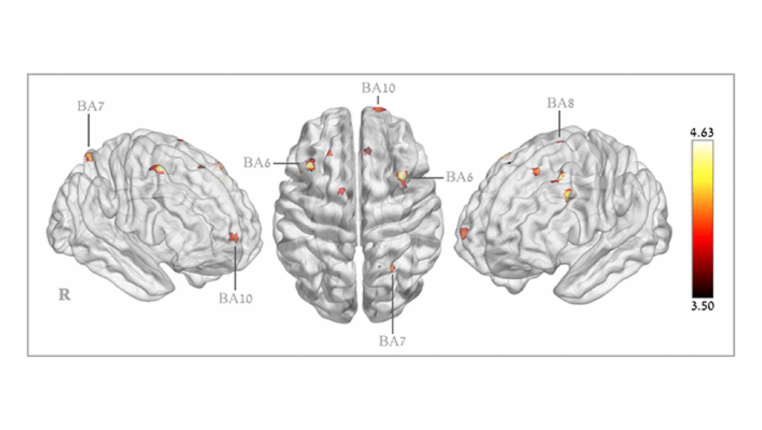Image: Figure 4. Brain regions with significant post hyperbaric oxygen therapy changes in cerebral blood flow.
The Top-Performer series highlights papers published by Aging that have generated a high Altmetric attention score. Altmetric scores, located at the top-left of trending Aging papers, provide an at-a-glance indication of the volume and type of online attention the research has received.
Read Aging’s Top 100 Altmetric papers.
—
Cognitive decline among elderly populations 60 years of age and older is common. At least 50% of all community-dwelling individuals in this demographic express concern about declining cognitive abilities. Interventions such as exercise, healthy diets, and cognitive training (if maintained habitually) have shown positive effects on cognitive function. Another intervention with cognitive benefits—dating as far back as 1662 (before the discovery of oxygen)—in short, is the ingestion of pure pressurized oxygen, or hyperbaric oxygen therapy (HBOT).
Hyperoxic exposures increase the amount of oxygen dissolved in the body’s tissues and induce hypoxia-like physiological effects, including stem cell proliferation and angiogenesis. Previous studies have shown that repeated intermittent HBOT improves cognitive functions in post-stroke, traumatic brain injury, and anoxic brain damaged patients, even years after an incident. While a number of studies have demonstrated that this therapy induces neurotherapeutic effects in injured patients, the effects of HBOT in normal aging populations had previously never been evaluated.
In 2020, researchers from Shamir (Assaf-Harofeh) Medical Center, Tel-Aviv University, and Bar Ilan University conducted the first published study examining the neurocognitive effects of hyperbaric oxygen therapy in normal aging populations. Their paper was published in Aging’s Volume 12, Issue 13, and entitled: “Cognitive enhancement of healthy older adults using hyperbaric oxygen: a randomized controlled trial.” To date, this research paper has received an impressive Altmetric Attention score of 111.
The Study
“The aim of the current study was to evaluate whether HBOT affects cognitive function and brain perfusion in normal, non-pathological, aging adults.”
A total of 63 patients were admitted into this study. The participants’ age, gender, right/left hand dominance, education, employment, medical conditions, medications, and other characteristics were collected at the start of the study. The median age was approximately 69 years old. Cognitive function of each participant was evaluated at baseline in terms of memory, attention, information processing speed, motor skills, and a number of other measures of neurocognitive function.
The participants were then assigned either the HBOT arm or the control arm of the study. Both groups had similar characteristics and cognitive function at baseline. Half of the participants received 60 daily sessions of HBOT over the course of three months. All post-intervention measurements were taken at least one week after the last hyperbaric session. The assessors were blind to the assignment each participant was given when reevaluating for cognitive function after HBOT intervention.
“Our protocol included 60 sessions of 100% oxygen at 2 ATA including 3 air breaks during each session in order to utilize the hyperoxic hypoxic paradox and minimize the risk for oxygen toxicity.”
Results & Conclusion
“In summary, the study indicates that HBOT can induce cognitive enhancement in healthy aging populations.”
While the researchers are forthcoming about limitations of this study, results show that 60 sessions of hyperbaric oxygen therapy improved attention, information processing speed, executive function, and global cognitive functions. Importantly, HBOT also significantly improved cerebral blood flow in certain cortical regions of the brain.
“Moreover, the HBOT group had a significantly enhanced brain perfusion in the superior and middle frontal gyri, supplementary motor area and superior parietal lobule.”
Click here to read the full research paper, published by Aging.
—
Aging is an open-access journal that publishes high-quality research papers bi-monthly in all fields of aging research and other topics. These papers are available to read at no cost to readers on Aging-us.com. Open-access journals offer information that has the potential to benefit our communities from the inside out and may be shared with friends, neighbors, colleagues, and other researchers, far and wide.
For media inquiries, please contact [email protected].

